The Regency is a period often regarded as the most elegant in the history of the decorative arts and architecture in Britain, at the height of the neo-classical movement. Named for the Regency of the Prince of Wales from 1811, crowned George IV in 1820, Regency describes the period ranging from 1790 to 1840. The achievements of George IV, and his huge influence in the arts, were too readily obscured by the monstrous personality of gargantuan appetites as caricatured by Gillray. This King, described by the Duke of Wellington as “…indeed the most extraordinary compound of talent, wit, buffoonery, obstinacy and good feeling – a medley of opposite qualities with a great preponderance of good – that I ever saw in my life”. The recent show at The Queen’s Gallery gave a better idea of the George’s lasting legacy as Prince Regent and King, in the unrivalled collection of works of art by the finest artists and craftsmen.
Highlighting the beautiful details and design features that were used in this era, our chosen objects show the elegance and fine craftsmanship of Regency lighting – from spectacular chandeliers to graceful candelabra and grand table pieces, all of which can enhance and add quality to traditional as well as contemporary interiors.
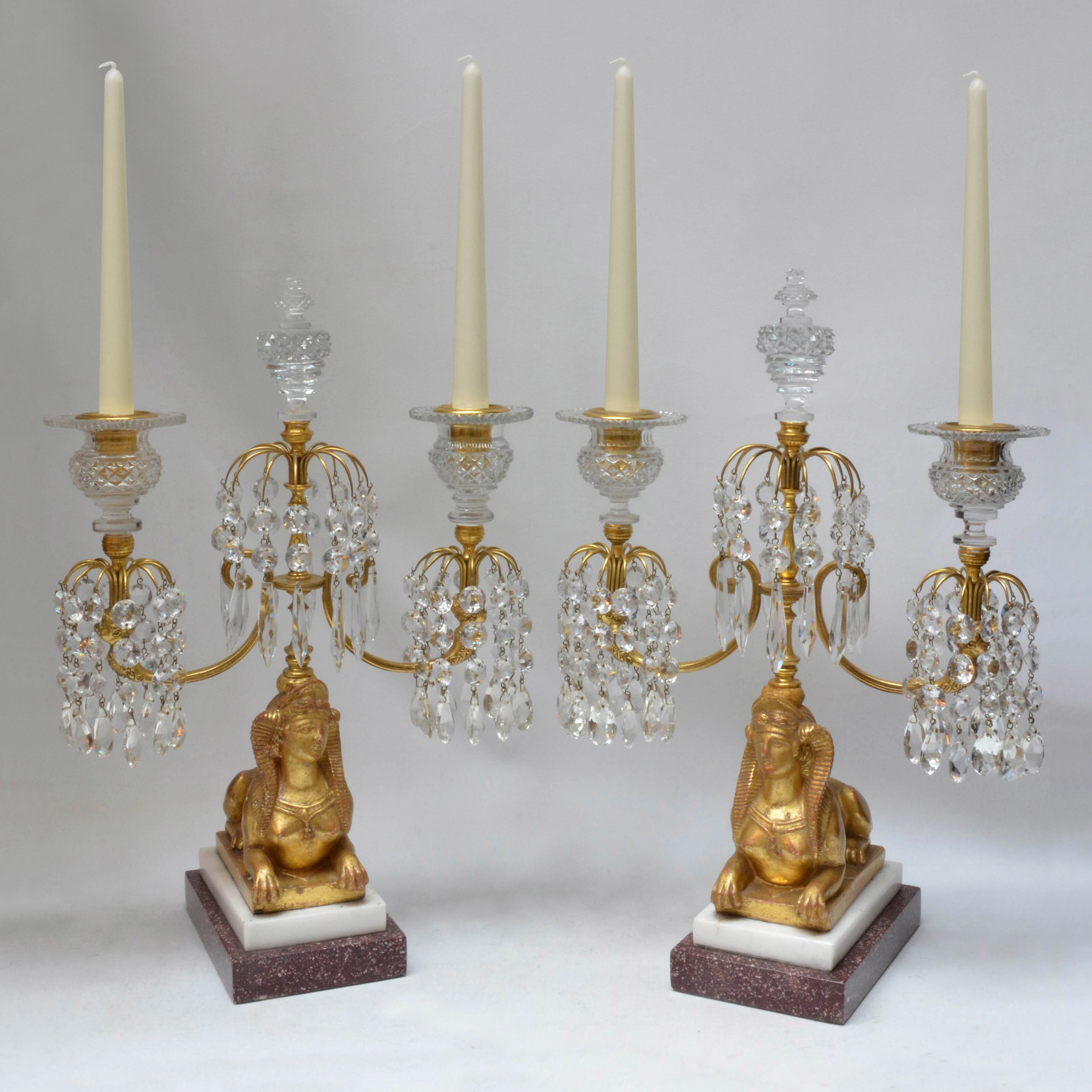
Pair of gilded and cut glass 'Sphinx' Candelabra on porphyry bases
We have selected this intriguing pair of candelabra because they illustrate the Regency fascination with ‘Egyptomania’ resulting from the extensive study of ancient Egyptian remains following Napoleon’s Egyptian Campaign (1798-1801). There were parties and public events with Egypt as a theme, where people wore special costumes. Images and motifs were widely used in the decorative arts, and candelabra like these would have been viewed as the height of sophistication and subtle learning. Humphrey Hopper, sculptor (1765-1844) exhibited at the Royal Academy and was best known for his plasterwork, often copies of classical figures which could be viewed at his home in Wigmore Street, London.
Pair of gilded and cut glass 'Sphinx' Candelabra on porphyry bases:
the gilded metal stretchers bearing diamond-cut glass candle-cups and umbrella fronds of cut glass pendants; supported by recumbent gilt gesso Sphinxes marked 'H. Hopper London Dec.10th 1806'; on white marble and porphyry rectangular bases. Restored.
Height: 17''- 43cm Width: 11''- 28cm
Projection: 6½''- 17cm
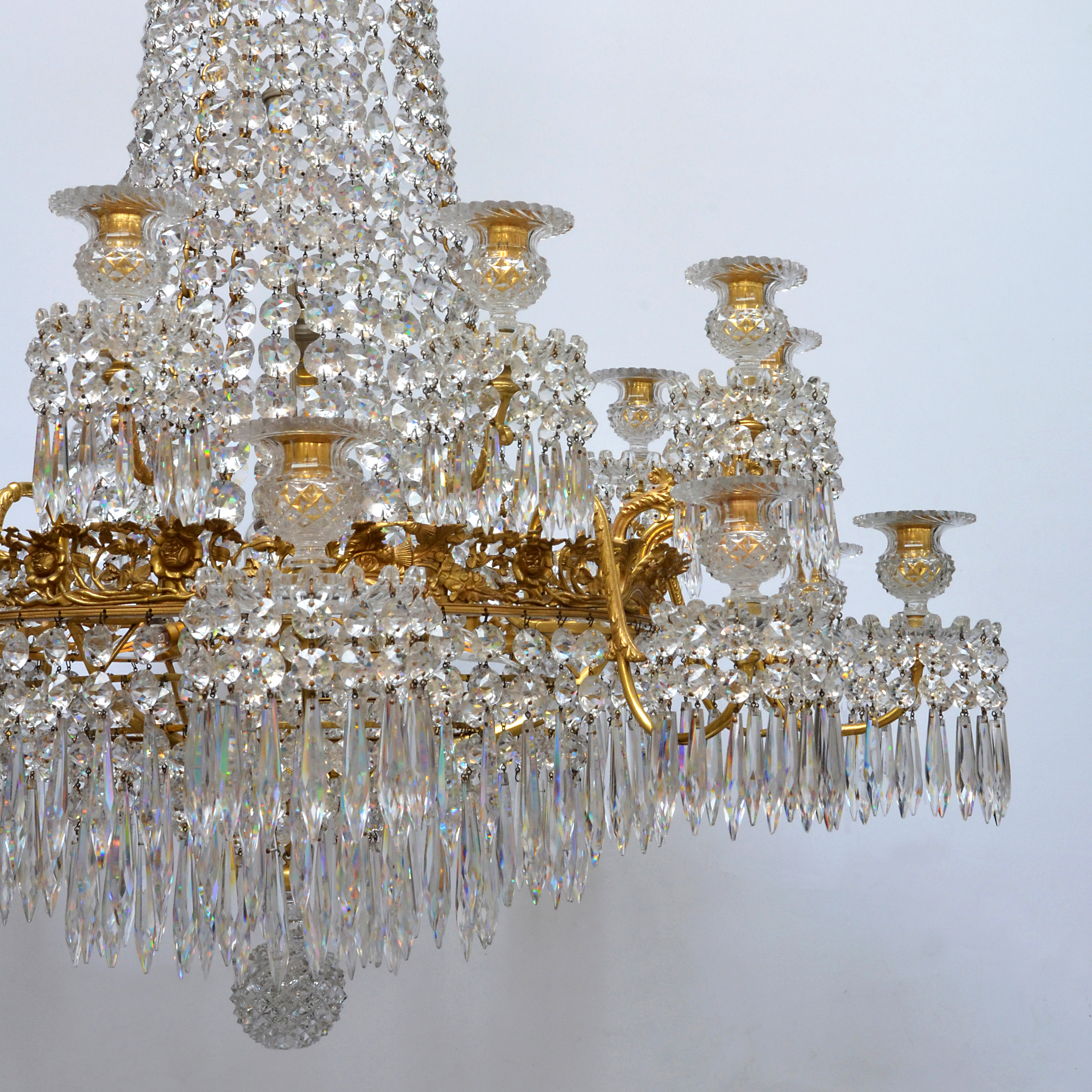
Large twenty light ‘Thistle-and-Rose’ Regency cut-glass Chandelier
This magnificent Regency period chandelier might have hung in a State ballroom or an important reception room. Its finely wrought frame represents the skill of metalworkers of the period. The rose and thistle are traditional emblems of England and Scotland. The multi-faceted cut glass prisms and ‘icicle’pendants with high lead content would have reflected the candlelight with myriad rainbow hues. Similar chandeliers may still be seen in Buckingham Palace and Brighton Pavilion, two of the Prince Regent’s creations.
Large twenty light ‘Thistle-and-Rose’ Regency cut-glass Chandelier:
the gilded-bronze pierced frame of thistle-and-rose design with the candle-branches on two tiers; dressed with ‘double-star’ prisms and ‘plain icicle’ pendants; with diamond-cut ball shaped finial.
Circa 1820, restored and rewired.
Height: 56”- 140cm Width: 40”- 103cm
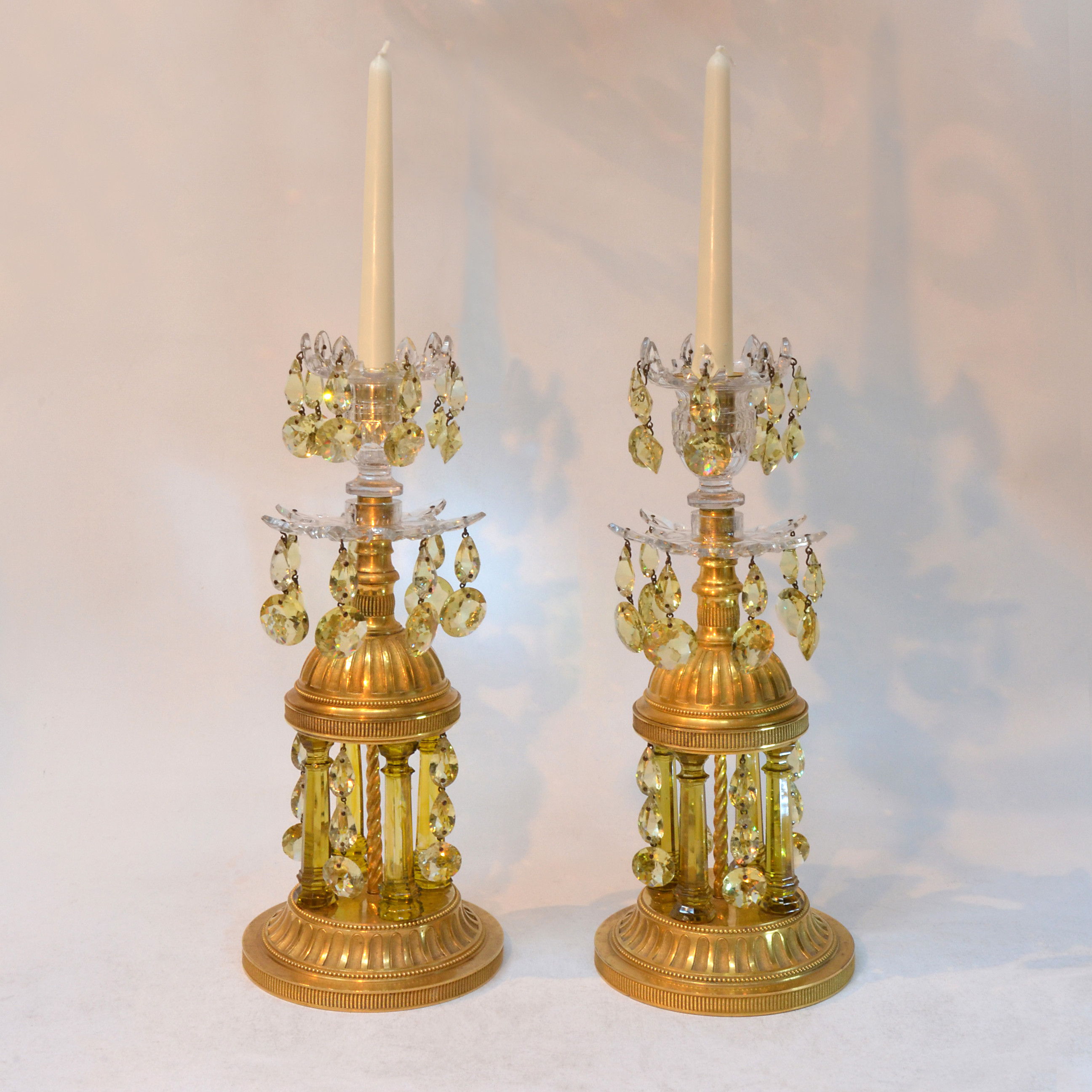
Pair of gilt bronze and cut glass 'Temple' Lustre Candlesticks
We selected this pair of unusually-coloured lustre candlesticks because they represent the Regency taste for all things classical. They were inspired by ‘Il Tempietto’ in Rome, a form favoured by Sir John Soane, neoclassical Regency architect of Dulwich Picture Gallery, which opened to the public in 1817.
Pair of gilt bronze and cut glass 'Temple' Lustre Candlesticks:
the scallop-cut glass candle cups and pans supported on a base in the form of a classical temple with ‘lemon yellow’ glass columns and finely chased gilt-bronze mounts; dressed with lemon yellow cut-glass ‘chain-pears’ and ‘double-star’ medallions. Inspired by Bramante's 'Il Tempietto di San Pietro' (1508) in Montorio, Rome.
Circa 1800, and restored.
Height: 13''- 33cm Width: 5''- 12.5cm
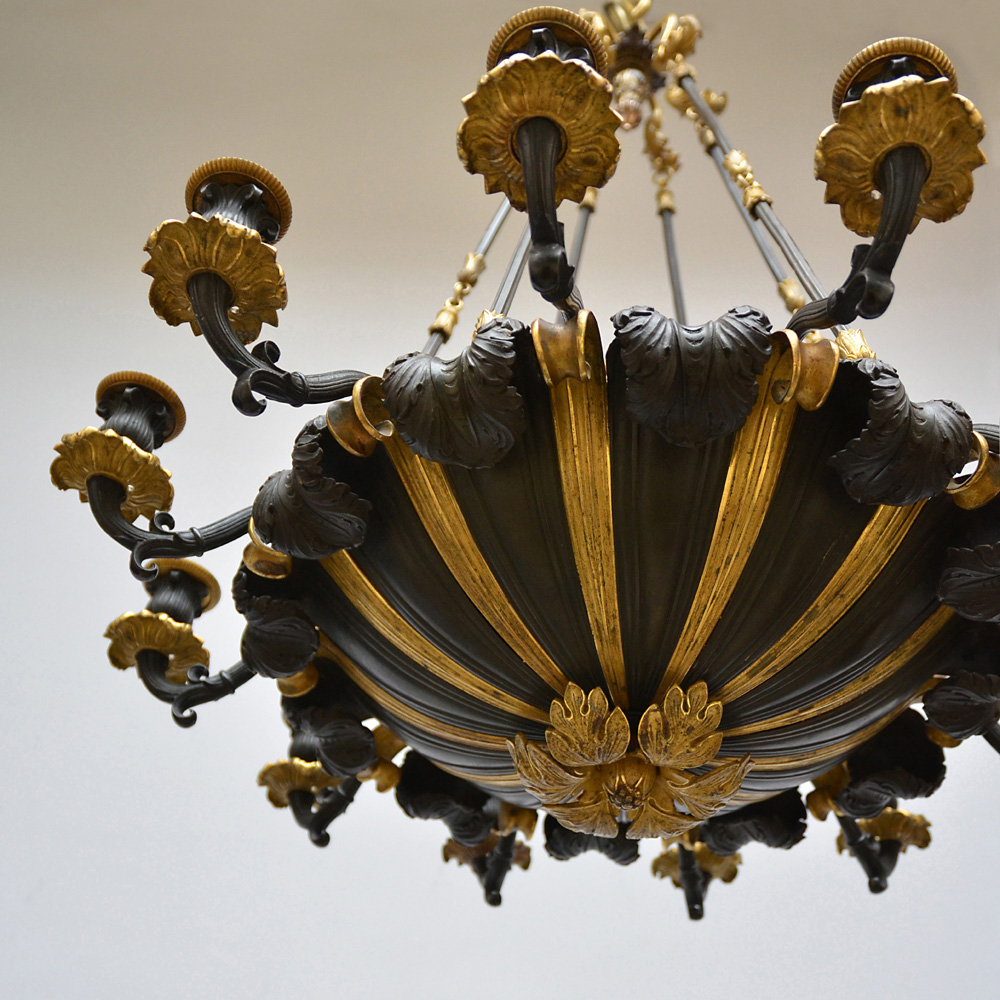
Regency gilded and patinated-bronze twelve branch Chandelier
This striking gilded-bronze chandelier contrasts with the cut glass Chandelier and shows the wide variety of styles in Regency lighting. This example was chosen for our exhibition for its bold design, contrasting the dark bronze colour of the dish with the gilded highlights and using classical anthemenion, acanthus leaf and bud motifs.
Regency gilded and patinated-bronze twelve branch Chandelier:
the dish with acanthus leaf decoration, bearing scrolling branches with gilded candle pans and leafy finial; the upper part rising to gilded anthemion crown and acanthus bud finial; suspended by four reeded rods with foliate gilded mounts to top gilded crown and ornamental top loop.
Circa 1820, and restored.
Height: 35”- 89cm Width: 26”- 66cm
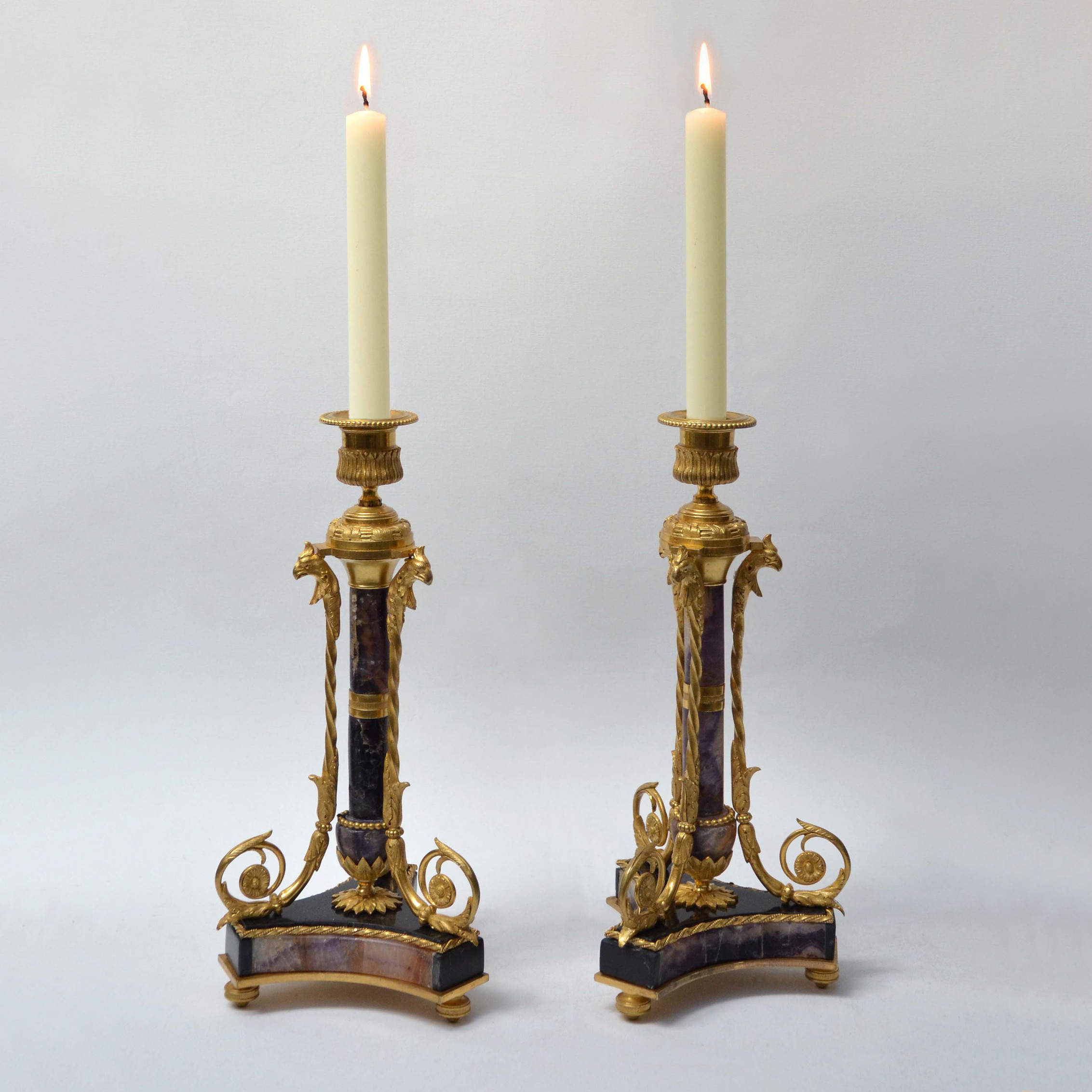
Pair of late Georgian ormolu and Blue John Candlesticks
The name ‘Blue John’ is thought to derive from the French ‘bleu jaune’ (blue yellow), referring to its lustrous jewel tones. Made from a rare and precious colour-banded form of fluorspar mined in a single hill in Derbyshire, England, such items were much prized in the 18th and early 19th Centuries. The finely-chased mount is in the manner of Matthew Boulton of Birmingham, whose work may be seen on many Blue John table items of the period.
Pair of late Georgian ormolu and Blue John Candlesticks:
with leafy candle cup above three twisted supports with eagle head finials and scroll terminals; enclosing a Blue John column on tri-form base raised on three small feet.
Circa 1820 and restored.
Height: 11''- 12.5cm Width: 5''- 12.5cm
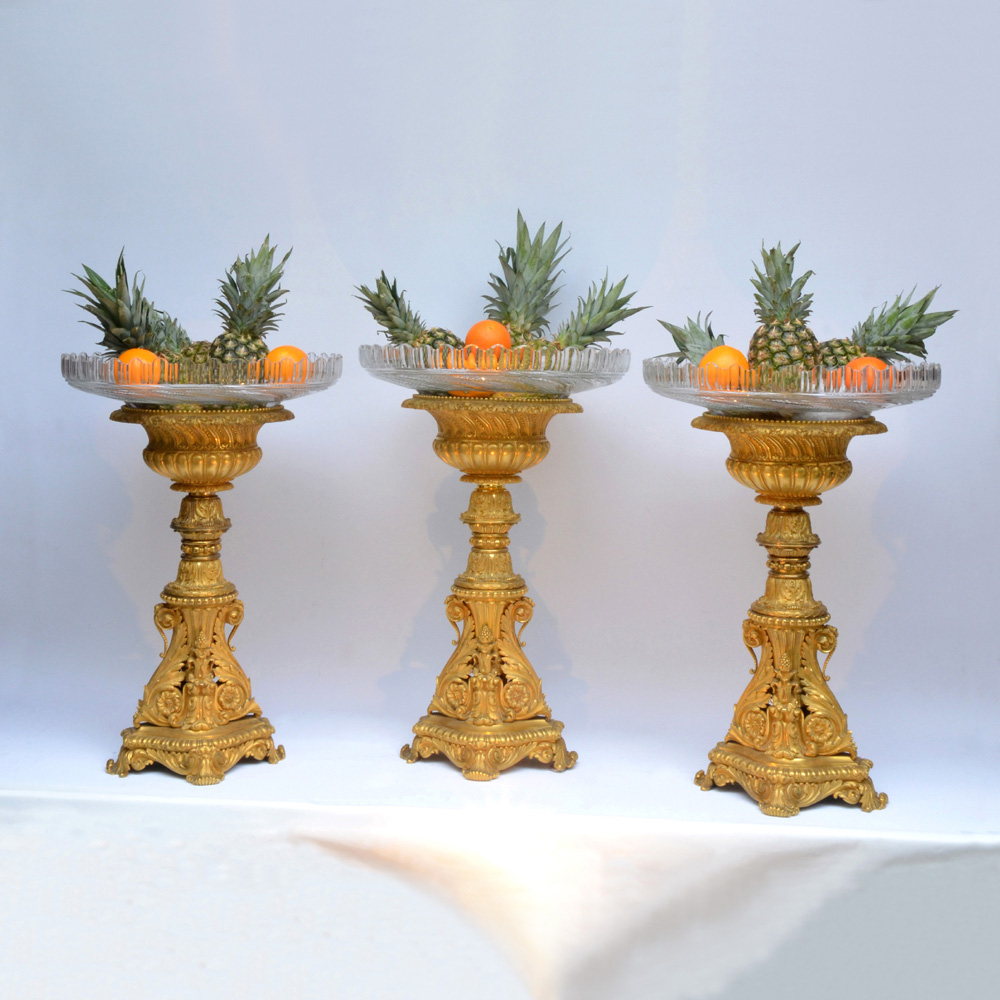
Suite of three Restauration gilded-bronze and glass centrepieces after Thomire
Thomire was particularly favoured by the Prince Regent, later George IV, whose French Confectioner acquired fine examples of his work for him in Paris. This led to George’s commissioning tazza stands and candelabra from Thomire, which are on display in the Banqueting Room of Brighton Pavilion as well as other royal residences. Despite ongoing hostilities in Europe, the firm was granted dispensation to trade with the Prince and so avoided bankruptcy. These centrepieces, although not marked, are of similar craftsmanship and date from the same period.
Suite of three Restauration gilded-bronze and glass Centrepieces after Thomire:
designed for grand dining tables, see Attingham Park et al. The stands of cast acanthus foliate design, with highly decorated stem on rhomboid base with four feet; bearing large cut glass dishes with petal edge and cut with spiral design and centre star. Thomire worked in Paris between 1800 and 1830 and was appointed premier bronzeur to the Emperor and was a favourite of George IV.
Circa 1830 and restored.
Height: 26''- 66cm Width: 18''- 46cm
